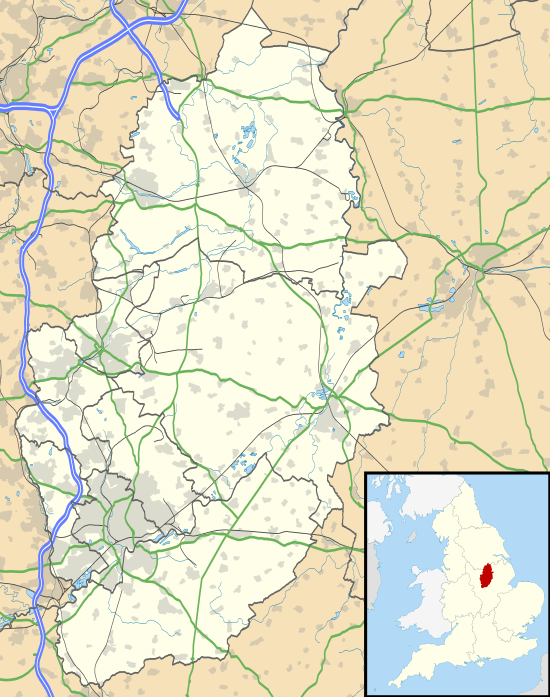Alverton
Alverton is an English hamlet in the Newark and Sherwood district of Nottinghamshire. It is joined by neighbouring Kilvington to form an area for a parish meeting. It contains 22 houses, surrounded by farmland.[1][2][3] The River Devon and its tributary, the Winter Beck, run along its eastern border. It is covered by the civil parish of Staunton.
- Alverton can also be a variant of Alverston or Alton.
Amenities
There is a Montessori nursery school at Staunton-in-the-Vale (1.6 miles, 2.6 km), primary schools at Orston (2.1 miles, 3.4 km) and Bottesford (3.6 miles, 5.8 km), and secondary schools at Bingham (7.3 miles, 11.7 km), Bottesford and Newark-on-Trent (7.5 miles, 12.1 km).
Alverton has no shops or places of worship. The nearest Anglican church is St Mary's at Staunton and the nearest Methodist church at Long Bennington (3.8 miles, 6.1 km). The nearest shopping centres are Bingham and Newark. The closest pubs are the Staunton Arms at Staunton and the Durham Ox at Orston.
Two buses run through Alverton on Wednesdays and Fridays between Newark and in the one case Shelton and the other Bottesford. The nearest train service is at Bottesford railway station on the line between Nottingham, Grantham and Skegness line.
History
Alverton historically formed part of Kilvington parish in Newark wapentake. It appears in the 1086 Domesday Book as Alvretun and Alvritun.[4] The township was recorded in 1832 as having only 16 inhabitants. It had been enclosed in 1806. The Lord of the Manor was recorded as Rev. Dr. Staunton, and its "two farmers" as Robert Cross and Charles Neale.[5] In 1870–72 it had seven houses and a population of 40.[6]
Ghosts
The former Staunton Church of England School in the village is now a private house, said to be haunted by a teacher once murdered there. There have been two purported sightings of a ghost at another house, The Chestnuts, each describing the figure of an elderly lady in Victorian garb, thought to be a former sempstress to Queen Victoria, Mary Brown, who had returned to Alverton as housekeeper to her widowed brother and ruled his four children "with a rod of iron".[7]
External sources
- Photographs of the old school and schoolmaster's house in 1978 appear in Our Nottinghamshire.[8]
- A 2014 photograph of the old school can be seen here.[9]
- A 1900 map showing Alverton and neighbouring villages can be found in the National Library of Scotland.[10]
References
- NG13 9PJ postcode Retrieved 17 January 2016.
- NG13 9PB postcode Retrieved 17 January 2016.
- Alverton & Kilvington Parish Meeting Retrieved 4 January 2013. Archived 7 September 2011 at the Wayback Machine
- Place Names of Nottinghamshire Retrieved 16 January 2016.
- White's Directory, 1832 Retrieved 16 January 2016.
- Vision of Britain Retrieved 16 January 2016.
- The Nottinghamshire Village Book. Compiled from materials submitted by Women's Institutes in the County (Newbury/Newark: Countryside Books/NFWI), p. 9.
- Retrieved 16 January 2016.
- Retrieved 17 January 2016.
- Retrieved 16 January 2016.
External links

- Alverton in the Domesday Book
- Alverton history in Thoroton's History of Nottinghamshire..., 1790. Retrieved 5 January 2014.
